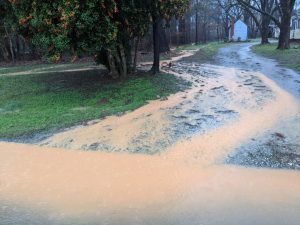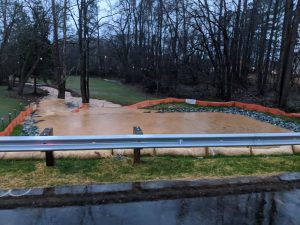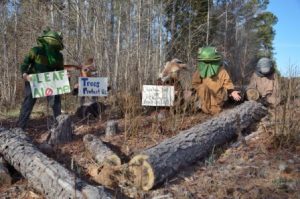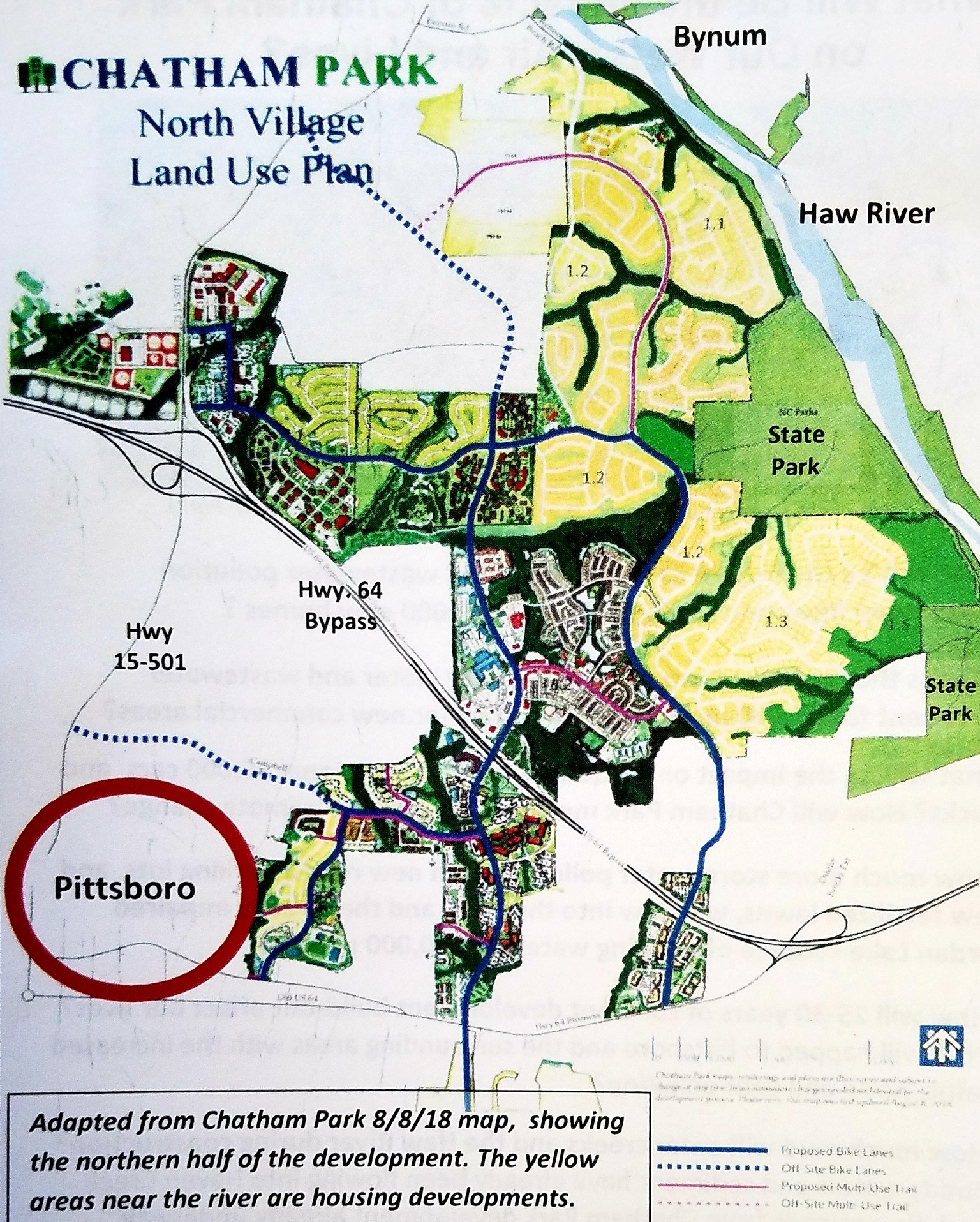Chatham Park, a new mega-development the size of Chapel Hill or Burlington, is being built in Pittsboro’s ETJ (extra-territoral jurisdiction) adjacent to the Haw River and Jordan Lake. It will be the biggest master plan development ever built in NC. As 8000 acres are developed from existing forestland, we are very concerned about the impacts on our waters and environment. We have fought for better protections, and will continue to do so, but are sorry to see our predictions of environmental degradation coming true.
Latest News on the Chatham Park Development:
December 2023: Disney Corporation Announces Plans to Build their newest “Storyliving” development in Chatham Park” North Village. Read Disney’s Announcement

The Haw River Assembly sent Disney Corporation and their Arizona based developer, DMB, an open letter on January 25, 2024 asking them to go above and beyond Chatham Park’s minimum requirements in order to protect the Haw River and the environment where they will be building.
We challenged them to apply the concepts they have committed to in their “Walt Disney Company 2030 Environmental Goals” to the Asteria Storyliving community. Read our full letter HERE.

In March, 2024 HRA launched a petition to Disney and DMB asking community members to join us in urging stronger environmental protections as Asteria Storyliving is built. We now have over 1000 signatures. You can sign the petition HERE. We also sent Disney and DMB a more detailed list of recommendations we would like to use. See the full recommendations HERE
HRA RECEIVES RESPONSE FROM ASTERIA DEVELOPER, DMB on April 5 and HRA WRITES BACK
HRA finally received a response on April 5, 2024 to our letter to Disney and DMB developers concerning their planned “Asteria Storyliving” development in Chatham Park. The letter was only from DMB,and echoed the statements from Chatham Park Investors that the standards approved for them to build under will be sufficient to protect the environment and Haw River. We disagree. We have not heard anything from Disney Corporation. HRA sent a response yesterday, April 25 to DMB and Disney hoping to make them more aware of the environment and community they will be impacting. We included photos of sediment violations during Chatham Park construction, and photos from our Procession of the Trees demonstrations in 2019 when we rallied to save more trees in Chatham Park. We also sent them our petition with the current signatures gathered so far. You can read DMB’s letter HERE and HRA’s latest response HERE
Previous Chatham Park News
We asked Pittsboro in 2023 to Deny the Chatham Park Amendments to their North Village Small Area Pla
Chatham Park Investors (CPI) have proposed amendments to their North Village Master Plan to the Town of Pittsboro, who has jurisdiction over this development. (Scroll down to see the information about the North Village Small Area Plan previously approved.) The Small Area Plan for North Village encompasses 2,225 acres between Pittsboro and the Haw River – not small at all! While the Plan previously approved will result in significant deforestation and environmental impacts, these new proposed changes will greatly increase the adverse impacts to the Haw River, the wildlife corridor, the Lower Haw State Natural Area, and downstream water quality in Jordan Lake.
These changes should be rejected by the Pittsboro Town Board of Commissioners. The North Village Small Area Plan is currently being reviewed by the Pittsboro Planning Board and expected to be discussed and voted on by the full Town Board of Commissioners at their meeting on August 28. We presented the petition to them on August 14.
LInk to the Pittsboro Town Staff Memo and Comments from the Public on the Amended North Village Plan: https://www.pittsboronc.gov/AgendaCenter/ViewFile/Item/405?fileID=4068
Link to the Full Chatham Park North Village Small Area Plan Amended Document:
https://pittsboronc.gov/DocumentCenter/View/2995/NV-SAP-Amendment—PB-Draft-06052023?bidId=
Link to HRA’s comments to the Pittsboro Town Board:http://hawriver.org/wp-content/uploads/2023/08/Revised-NV-SAP-Comments-from-Haw-River-Assembly.pdf
Our Petition to the Pittsboro Town Board asked them to reject the amended North Village Small Area Plan (presented to Board on August 14, signed by over 1500 people)
How the Pittsboro Town Board Voted
-We asked them to reject a proposed through-road route that would go very close to the Haw River buffer – rather than a more direct and central route. This new road alignment would create more traffic, light, noise, and runoff pollution near the river. The Town Board allowed this new route
– We asked them to reject a plan for a 10 ft wide, paved Chatham Park pedestrian and bicycle greenway, in a 30 ft cleared easement along the Haw and through the Lower Haw River State Natural Area. Any trail along the river should be apart of the overall Haw River State Trail Plan, and be a natural surface trail in keeping with conservation goals for the State Natural Area. They will allow a paved trail
– Reject any further weakening of tree coverage requirements; and ensure compliance of Chatham Park’s prior commitment to 35% tree coverage of preserved existing trees within 2000 ft. of the Haw River; The Town Board did not require CPI to ensure this percentage, despite allowing a new road that could be built within 300 ft of the river.
– Reject Bynum Beach Road being used by North Village for anything other than emergency access. There should be no widening or expansion of this road, which is very close to the river and within a flood hazard area. The Town Board agreed to Bynum Beach Rd. only being used for emergency access.
These Additional points were not discussed by the Town Board, although the public brought them up.
– Require swales instead of Curb and Gutter: The Town should require alternatives such as swales instead of curb and gutter for all roads, streets and alleys within a 1000 ft of the Haw, and within the “regulatory” and “voluntary” stream buffer areas for all stream crossing road sections not yet constructed (including in the future South Village)
Reject the Boundary Changes: Nine planning sections have boundary changes with a net loss of contiguous dedicated non-residential acreage, not required or related to the relocation of the hospital as CPI claims. Some separate non-residential acreage needs to be maintained for some future job-growth opportunity, different from the retail or office park uses that are shrinking away.
Reject Changing Tree Coverage Planning Areas: Many Tree Coverage Planning Areas (TCPAs) are enlarged, especially in residential sections between the Village Center and the Haw. This is NOT justified (as claimed) by “more apartments” as there is only a listed increase of 384 apartments in the entire North Village. Haw River Park tree coverage shouldn’t be used as an offset for a larger area. Tree coverage is needed to offset heat sinks throughout Chatham Park.
Parks and Parkland: There many proposed revisions related to parks. Two park areas have been deleted, a third has changed boundaries, a fourth possibly altered or enlarged but not clearly enough, and 30 acres of a larger park area miles away at the southeastern tip of C.Park towards Moncure is supposed to substitute for parks actually in the N.Village.
More Age Restricted Housing? There is an increase in the percentage of housing units that will be age restricted developments. At what point is it too much? If these are more of the upscale developments with housing units priced $550,000 on up this means yet more new housing that could be unavailable by both price and age restrictions

BACKGROUND INFORMATION ON CHATHAM PARK
Chatham Park, a new city the size of Chapel Hill or Burlington, is being built in Pittsboro’s ETJ (extra-territoral jurisdiction) adjacent to the Haw River and Jordan Lake. It will be the biggest master plan development ever built in NC. As more than 7000 acres are developed from existing forestland, we are very concerned about the impacts on our waters and environment. We have fought for better protections, and will continue to do so, but are sorry to see our predictions of environmental degradation coming true.
Environmental Pollution as Chatham Park is Being Built
Chatham County Watershed Protection Dept. Staff have issued 10 Notices of Violation for sediment and soil erosion problems from January 2019 – Sept. 2021. Not included are many other incidents that required corrective actions after county inspections.
Muddy water on Feb. 6, 2020 flowing through yards and forest to Thompson St. in Pittsboro from Chatham Park’s construction site for The Vineyards and Thales Academy.
The huge rainfall over 2 days in February 2020 brought the Haw River up to major flood stage in Bynum. We have been seeing more of these non-hurricane major floods in the past few years, triggered by climate change and development that replaces forest with rooftops and pavement. The Town of Pittsboro has seen increased flooding of yards and roads after these huge rain events. Older neighborhoods are being damaged by the flooding from new development. Stormwater and floodplain regulations need to be improved in order to deal with the amount of rainfall/hour happening with these storms.
The Mosaic at Chatham Parks pays $10,000 Fine for Violation on January, 2020

The Mosaic development at Chatham Park had its Land Disturbance Permit revoked on January 10, 2020 by Chatham County’s program for Sedimentation and Erosion Control, after a worker drove heavy equipment through a stream on the property.
The developers paid a $10,000 permit re-instatement fee once they took corrective measures. But what is a stream worth? We expect Chatham Park to make sure that workers have knowledge of environmental laws, and are under adequate supervision to ensure this kind of incident does not happen again.
BACKGROUND ON CHATHAM PARK ISSUES:

Pittsboro Town Board Approves Chatham Park Development Agreement and North Village Small Area Plan, with few changes to these insufficient plans (updated Oct. 2021)
(To get updates on Chatham Park issues send an email to info@hawriver.org to be added to our listserve)
Chatham Park Development Agreement – Who Does it Benefit?
The Development Agreement between Chatham Park Investors (CPI) and the Town of Pittsboro would cover 40 years and ALL of CP’s current 7091 acres, and even allow more land to be pulled in under the agreement in the future. All the perks seem to be for Chatham Park, with many costs and uncertainties falling on Pittsboro. It would lock the Town into an agreement far into the future, despite changes driven by climate change, the economy, water shortages, and more.We strongly disagree that CPI is doing enough to protect “natural resources and environmentally sensitive property within the Property” or “minimization of adverse off-site impacts” that are supposed to be benefits to the Town from this Agreement. The Tree Protection, Open Space and Stormwater Elements are NOT sufficient to protect natural areas, wildlife habitat, forest cover and waterways, and current construction has already led to degradation of waters of the Haw River. Unfinished discussions and plans between CPI and Pittsboro include the lack of an Affordable Housing Element, and no plan yet for South Village. The Development Agreement commits Pittsboro to paying for amenities and infrastructure that should be CPI’s responsibility, or shared with new Chatham Park residents, not just the current Town taxpayers.
Link to the latest Chatham Park Development Agreement (submitted July 1 2021) (skip to page 80 for the “clean” version, instead of red-lined changes)
LInk to Haw River Assembly’s full Talking Points
North Village Small Area Plan
The Small Area Plan (SAP) for Chatham Park’s North Village development covers ~ 2,225 acres. It’s not so small – and it will include over 7500 dwelling units, as well as 11 million sq. feet of commercial,institutional buildings. The North Village is located between the Haw River, US 64 Business, and US 15-501 and will have very large impacts on the Haw River, on the wildlife that will be harmed and displaced by this development and on the lives of those who live here already. The Town Board will continue their discussion (and might vote) on the SAP at their July 26 meeting and said they will take public input. Both this Small Area Plan and the Development Agreement raise many questions about who is paying for some of the costs of North Village as it grows – current or future residents?
Link to North Village SAP and additional documents.
The Town of Pittsboro has the decision making authority for Chatham Park. Contact info for the Town Board and staff:
Town Board of Commissioners
James Voss jvose@pittsboronc.gov
Kyle Shipp kshipp@pittsboronc.gov
****************************************************************
The State NC Division of Water Resources approved the 401 certification for Chatham Park and DOT. It still does not have adequate protections
The initial 401 Application was denied by the state due to incomplete and conflicting information. We believe the revised permit still does not provide adequate information, or justification for the negative impacts it will have on water, the environment and the surrounding community, and should be denied again. The 2240 acres of North Village and the new North Chatham Parkway could be built without this permit. Final approval of the permit by the state included a long list of conditions, but they do NOT satisfy our concerns about stormwater, cumulative impacts and other issues. Read our letter to NC and Town Board HERE.
***************************************
Earlier News:
State Initially Denies Chatham Park’s Initial 401 Application
Chatham Park Investors and DOT applied for a 404 permit from the US Army Corps of Engineers (ACE) that would allow over one mile of streams, and over 2 acres of wetlands to be destroyed as they build North Village and Chatham Parkway. This permit would cover all of Chatham Park’s land between Pittsboro and the Haw River, as well as a new major roadway. Construction projects of this size must have a state 401 Certification approved in order to build in, dredge, fill or otherwise disrupt or destroy wetlands and streams.
On June 1, 2020 the NC Division of Water Resources (DWR) sent a letter to Chatham Park Investors (CPI) and NC DOT denying their application for the 401 Certification. No work can be done in Chatham Park for the North Village development that would impact streams and wetlands, without the 401 Certification. DWR told CPI that the 401 application was incomplete due to a large number of reasons – many of which HRA pointed out to them in our comment letter to DWR and the Army Corps of Engineers. Reasons for denial include an incomplete analysis of indirect and cumulative impacts and incomplete stormwater management information.
Thanks to everyone who sent comments in, and a big thanks to the Chatham County Board of Commissioners for letting the state know their concerns about the permit and the inadequate public opportunity for commenting. Read HRA’s Comment Letter HERE
You can read the full denial letter from DWR to Chatham Park Investors here: https://edocs.deq.nc.gov/
Chatham Park Investors can appeal this decision, or re-submit with more complete information. We will be watching carefully, and will let you know what happens next, and actions we can take.
BACKGROUND ON CHATHAM PARK ISSUES:
Throughout the watershed, large scale developments are occurring at a rapid rate. In some cases, development and growth are necessary, and it is not always done poorly. However, when developers place profit over human and environmental health, Haw River Assembly and our passionate members will take action. The largest of all these is Chatham Park, a new city the size of Chapel Hill or Burlington, being built in Pittsboro’s ETJ (extra-territoral jurisdiction) adjacent to the Haw River and Jordan Lake. It will be the biggest master plan development ever built in NC. Read our concerns below.
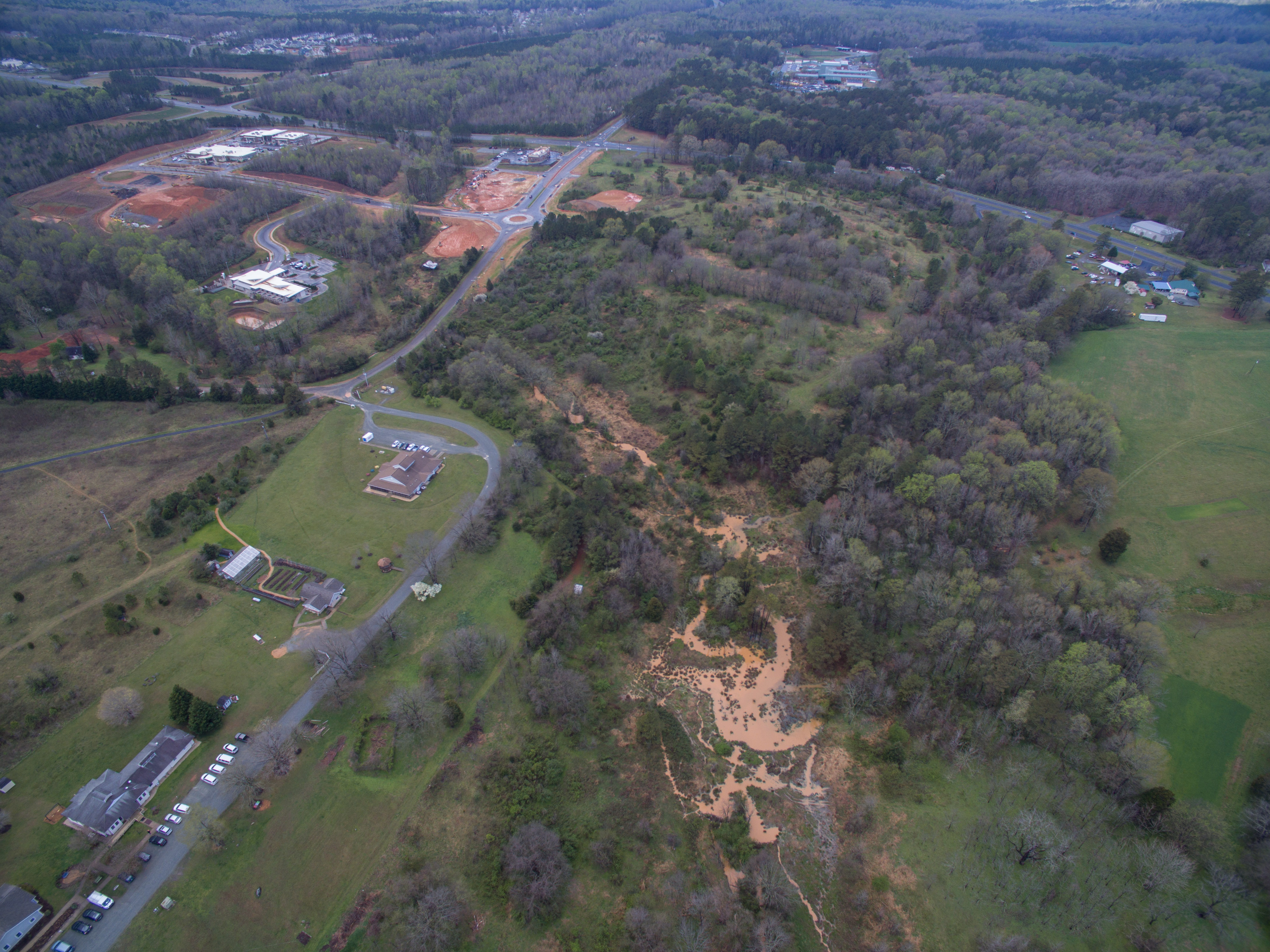 (aerial view of muddy waters from Chatham Park construction, near Hwy 15-501)
(aerial view of muddy waters from Chatham Park construction, near Hwy 15-501)
Chatham Park will be bulldozing a huge portion of their 7000 plus acre development, which is now mostly forested land. As trees are replaced by buildings and roads, those hard surfaces will increase the stormwater flowing off the land, which can increase flooding and pollution to streams, and to the Haw River and Jordan Lake. Chatham Park’s approval by the Town of Pittsboro included a requirement to use “exceptional design” to protect the environment, which includes managing stormwater. HRA believes it will not be possible to adequately control stormwater flooding and pollution with the number of houses and commercial areas they plan to build in this new city for 55,000 residents. We’re urging the Town for more trees and natural areas to be saved in this environmentally important land near the Haw River and Jordan Lake.
A general overview of our environmental concerns regarding Chatham Park can be viewed in this slideshow from 2015, ” Conservation of Critical Resources in Chatham Park”
An article HRA wrote that was published in the Chatham County line in September 2016 discusses “Is Chatham Park Sustainable?”
Though the Master Plan has been submitted and approved, many aspects of Chatham Park are not set in stone, and we will continue to educate the public and our elected officials and advocate for the health of the Haw River and Jordan Lake. Chatham Park’s Additional Elements have not been approved by the Town of Pittsboro, and these elements could have devastating implications on the health of our river.
(The above map shows the northern half of Chatham Park, above Hwy. 64 Business)
US Fish and Wildlife Concerns about Impact of Chatham Park
In 2010, there was an Environmental Impact Statement (EIS) turned in to NC DENR as part of the NPDES application for an expanded Wastewater Treatment Plant permit for Pittsboro that would include new discharges into the Haw River. In that EIS, Pittsboro agrees that in regions of the Haw that support the endangered Cape Fear Shiner , there will be larger riparian buffers and a zero percent change in the stormwater hydrograph after any development. This means that the water flow rate and quantity must be the same as pre-development levels, which is currently mostly forested land.The EIS can be found here. The most recent letter from the US Fish and Wildlife Service stating the implications of this agreement by Pittsboro to protect the Haw River can be found here.
Pittsboro and Chatham Park Oppose State’s Letter Telling them To Protect the Haw River (concerning the EIS in paragraph above). Where is Public Transparency?
On May 3, 2018, the state Division of Water Resources sent a letter to the Town of Pittsboro saying that they needed to follow the mitigation strategies for new development (north of Hwy 64) for greater protections for the Haw River, especially wider stream buffers and enhanced stormwater management. Pittsboro had committed to these strategies in the EIS (environmental impact statement) that was part of their 2010 NPDES (wastewater) permit. HRA asked the Town repeatedly if they had replied to the state’s letter but were not given an answer. We used public records requests to find out the following information:
On June 4, 2018 both the Town of Pittsboro and Chatham Park sent petitions for a contested case hearing to challenge the Division of Water Resources (DWR) letter and to contest that Pittsboro needed to carry out the commitments it made in that EIS. In July, the Town and Chatham Park asked (and were granted) a stay for the hearing so that they could have discussions with DWR. The stay has been repeatedly extended. Discussions have now been continued until April 10, 2019.
On September 8, 2018 Haw River Assembly sent a letter by email to the Pittsboro Town Board and Mayor apprising them of what we know and stating “… the Haw River Assembly believes that the public deserves to know what these discussions entail, since our air and water quality in the area surrounding Pittsboro will be greatly impacted by the development of Chatham Park, as well as the health of the aquatic ecosystem of the Haw River” We believe the Town of Pittsboro should live up to their commitments to protect the Haw River made in 2010, and insist that Chatham Park take greater measures to protect water quality in their massive development, instead of contesting it.
On Tuesday, Sept. 18, 2018 the Southern Environmental Law Center sent a LETTER to the NC Dept. of Justice and DEQ on behalf of the Haw River Assembly, urging the state to hold Pittsboro and Chatham Park responsible for protecting the Haw River and to hold them to the commitments made in the 2010 Environmental Impact Statement.
Despite Opposition, Pittsboro Approved the Chatham Park Stormwater Element and Design Manual for Chatham Park on Oct. 8, 2018
The “Additional Element” for Stormwater, is analogous to Town’s Stormwater Ordinance, but applied just to the Chatham Park Planned Development District (which has it’s own ordinances). The Chatham Park Stormwater Design Manual includes a point system that developers would use to meet a higher standard for environmental protections. But, HRA has many concerns about the Stormwater Element and it’s untested “point system”, which may actually reward contractors for doing what is already required by law. In February 2018, we submitted comments to the Pittsboro Board of Commissioners on the latest version of the Stormwater Element and design manual. Read our comments here.
We believe that this vote should have been delayed until the Town and Chatham Park have concluded their current discussions with state agencies about the need for greater protections for water and the environment, including stormwater (that Pittsboro committed to as mitigation strategies in their 2010 NPDES Permit for wastewater).
On Nov. 15, 2018, Southern Environmental Law Center filed on behalf of the Haw River Assembly to Intervene in the Contested Cases in Order to Protect Haw River & Jordan Lake from Impacts of Massive Chatham Park Development in Pittsboro.
On March 2 2019, our Petition to Intervene was denied by the Administrative Law Judge.
On April 5, 2019 Southern Environmental Law Center filed a Petition for Judicial Review to appeal that decision.
Settlement Agreement Approved by Pittsboro Town Board Made Changes in Riparian Buffer — Open Space Element must be re-opened for approval
We are very disappointed that the settlement just reached between Chatham Park/Pittsboro and the state does not require stronger environmental protections for the lands that will be developed by Chatham Park, especially near the Haw River. There are a couple of aspects worth noting:
1. Opening up the Open Space Element for Pittsboro Town Board approval of the new riparian buffer language agreed to in the settlement, means it will have to go back through the planning board, public hearings and Town Board approval. This might give us a chance to get the buffer on the Haw River near Bynum increased by at least the 50′ we asked for. We can also urge that changes be made in the riparian buffer Table of Uses that is part of the settlement. The current Table allows applying fertilizer within the buffer; fences (which could prevent wildlife corridor use); types of road crossings and impacts, and other uses that do could harm these additional riparian buffers, or the waters they are meant to protect.
2. The website that will be created to track the stormwater point system will be accessible to state agencies who we hope will take a hard look at how this untested and unproven method for stormwater management will play out in real life development projects. The use of a password protected website for this data is a burden on the public’s ability to also evaluate this data. HRA will use public records requests as necessary to obtain the information.
A Quick Summary:
1. Riparian buffers: The only changes from the current Open Space Element are:
a. CPI will provide a 1000′ buffer along the Haw in the area designated in the Master Plan as Park land instead of 500′. This does not seem like a big sacrifice since they aren’t giving up ANY housing units, and had already been telling the Town they would increase this buffer (though that may be due to pressure from state during the talks).
b. They did NOT add 50′ to the 300′ buffer on the Haw in the upstream section near Bynum Beach, which we heard them say they were doing during a Town meeting. I think this was instead of a previous idea that homeowners would leave the 50′ of their propery closest to river buffer in a natural state.
c. The new language for the “additional buffers” makes them more permanent in the future – any changes would need to go through the Town, not CPI (see page 6, 3-e in Settlement).
2. Table of Uses Allowed in Riparian Buffers There are many text changes but almost none of them give more protection of the buffers. There are only 2 categories now, “Exempt” or “Allowable” – they eliminated the Allowable with Mitigation” which might have been stricter. The original language often had larger impacts only allowed with mitigation.
3.There is a new section for Stormwater Element Design Manual that will require more information from developers up front about the point system, and details on stormwater performance tracking (This is the new section Exhibit 2, on pages 26-27 of Settlement)4. The language in the Settlement concerning requirements for tracking Stormwater Control Management (SCM) on pages 3-4, would have data uploaded to a password protected website that ONLY the CPI, the Town and the state can see. How will the public be able to access this information? We have a need to know how the stormwater point system actually works.
Where are the Trees?
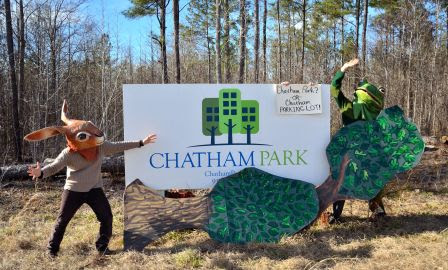
Chatham Park Submits Inadequate “Tree Protection Additional Element”
Chatham Park, a proposed planned development on over 7000 acres, submitted the latest revision of their Tree Protection Additional Element to the Pittsboro Town Board for their approval. We believe their proposed ordinance for minimum tree coverage and retention of existing trees is completely inadequate, and is full of loopholes.
Chatham Park could end up with a lot fewer trees than other cities in NC, a particularly tragic fate for this beautiful forestland along the Haw River and Jordan Lake. The revised Chatham Park Tree Protection rules would only require saving as little as 10% of the existing trees in much of Chatham Park’s development, with 0% in some of the densest areas, and with only 20% – 25% coverage in some residential areas after replanting (25% if all sparsely planted saplings). In contrast, the current tree canopy (the amount of branches and leaves overhead) within the Town of Pittsboro is about 50%. Chatham Park claims that there saplings will eventually grow to provide equal tree canopy, but we do not see how their proposed Tree Protection Element would make that a reality.
We believe there should be zero exceptions to providing or saving trees, even in the most densely urban areas. The more urban an area, the greater the need for trees to provide shade and heat reduction, oxygen and better air quality and buffers against stormwater impacts. All new development must be seen in the context of how it impacts climate change and as currently proposed, Chatham Park will have a negative impact. At the very least, dense development should trigger much more preservation of the existing mature forest in Chatham Park, in unfragmented areas, especially in the 2000 ft. buffer along the Haw River, as was designated in Pittsboro’s Land Use Map.
Chatham Park claims to have based these rules on the city of Durham’s tree protection ordinance for their urban tier, meaning Chatham Park is using a model for density that would mimic the most urban kind of development. We do not believe the density and sparse tree coverage proposed by Chatham Park can be done without great harm to the Haw River, wildlife (including endangered species) and to Jordan Lake’s drinking water. Durham does not think their tree ordinance is protective enough, and is currently working to update it to be much more protective. See new ordinance changes: https://durhamnc.gov/AgendaCenter/ViewFile/Item/2830?fileID=11238 Other cities are also trying to find ways to maintain or increase tree coverage. In an article in 2016 from UNC Urban Institute on Charlotte, A City of trees, but for how long? Canopy is loved but threatened they said: “In response to studies showing that the tree canopy was disappearing faster than it was being replanted, the Charlotte City Council in 2011 adopted a “50 percent by 2050”. The Town of Cary (home to Chatham Park developers) has 46% tree canopy coverage. Even New York City has tree canopy coverage of 24% .
Chapel Hill is a city of about the same population (almost 60,000) that Chatham Park is proposing. Chapel Hill’s tree coverage ordinance requires 30 – 40% tree coverage for almost all new development. The known benefits of trees for air quality, water protection, and prevention of flooding are well documented. That’s why Chapel Hill’s tree protection ordinance was used as a model for Pittsboro by the town’s Conservation Ordinance Review Committee after their review of all NC municipal tree ordinances. Importantly, this Pittsboro model tree protection ordinance states that the highest priority is to maintain the existing trees. Chatham Park has argued that eventually the trees that are replanted will grow to provide a larger tree canopy cover, and that existing trees in open space, streets and mandated buffers will add to that. But how many trees? And how many will survive? Chatham Park should preserve more of the existing forest before the bulldozers arrive.
The bottom line is that in order for Chatham Park to fulfill the stated purposes of their Tree Protection Plan Additional Element, they will need to preserve much more of the forest that exists there today. You can read the Haw River Assembly’s HRA Letter to Town Board.
It was a great turnout for the “Procession of Trees” on Feb. 15, 2019 !
150 to 200 people turned out to Speak for the Trees in Pittsboro, to show the Town Board our support for saving more trees in Chatham Park . Much thanks to everyone for coming and to Jan Burger and other folks from Paperhand Puppet for all the art and puppets! Watch a short video https://youtu.be/KJmCWJuMP5A about the Chatham Park Tree Protection issue – with footage from the Procession of the Trees (produced by Amanda Roberson with her footage, plus video and photos by Peter Theye, Mark Barroso and Gary Simpson). See more photos of the event. taken by Gary Simpson https://www.dropbox.com/sh/q89ryruyjj90kpc/AACpj2YhokY7ZJNfX203uJfia?dl=0
More resources on the importance of trees in urban and developed areas
How Many Urban Trees Are Needed to Lower Urban Heat? A new study from University of Wisconsin concludes that for urban tree canopy to have any meaningful effect on heat reduction, there must be a minimum of 40% coverage
Tree Coverage Area and Tree Root Protection Raj Butalia sent information to the Pittsboro Town Board that looks at Chatham Park’s use of “Tree Coverage Area” for tree protection in their development, instead of the more commonly accepted use of Tree Canopy. He explains why “Tree Coverage Area” may not adequately protect the large root area of mature trees. Read his report
2000′ Haw River Buffer Overlaid on Chatham Park Proposed Development The Pittsboro Future Land Use Plan shows a buffer area of 2000; along the Haw River. Click on these maps to see what that 2000′ looks like when overlaid on Chatham Park’s map of their proposed North Village area (between Bynum ad Hwy 64)
HRA Suggestions to Town Board for Greater Percentages of Tree Coverage and Why Chatham Park Needs Trees PLUS Affordable Housing Read the Letter
The revised Tree Protection Element was approved by Town Board on June 10,. 2019
What did Chatham Park change – or not – in the latest revision?
Strengthened language encouraging developers to buy trees from local nurseries
Revised Tree Coverage Planning Area (TCPA) definition. This does not seem to be what the Board wanted for clarity and more restricted use of this averaging tool. It still allows too large of areas (and currently undefined) to average tree coverage. leaving too few trees in some places.
Made “refusal”by town the default for developers who want to build sooner than 5 years after clear cutting.
Added a new section to Tree Coverage Area chart to show greater protection for trees within the 2000′ buffer of the Haw River. 35% of the existing trees within the 2000′ from the Haw must be preserved.
CP did not change the requirement for replanted understory trees to be one per 1000 sq. ft. for newly planted trees instead of 2000 ft This is still not in the revised Element even though Board has asked CP twice to change it. This is much too sparse, especially since canopy tree planting requirements are just one tree per 750 sq. ft.
Keep Up to Date on These Issues
If you would like to be added to a list serve for updates from Haw River Assembly on Chatham Park please send your name, email address, and location (your county or city) to info@hawriver.org



